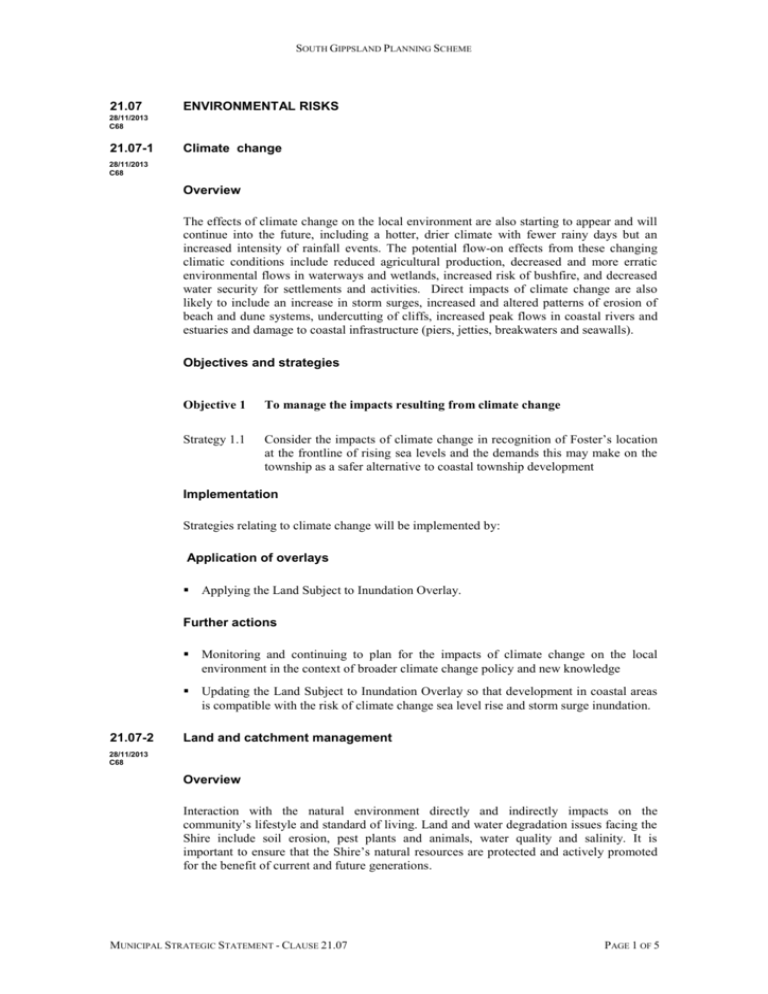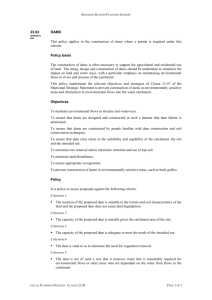21_mss07_sgip - Department of Transport, Planning and Local
advertisement

SOUTH GIPPSLAND PLANNING SCHEME 21.07 ENVIRONMENTAL RISKS 28/11/2013 C68 21.07-1 Climate change 28/11/2013 C68 Overview The effects of climate change on the local environment are also starting to appear and will continue into the future, including a hotter, drier climate with fewer rainy days but an increased intensity of rainfall events. The potential flow-on effects from these changing climatic conditions include reduced agricultural production, decreased and more erratic environmental flows in waterways and wetlands, increased risk of bushfire, and decreased water security for settlements and activities. Direct impacts of climate change are also likely to include an increase in storm surges, increased and altered patterns of erosion of beach and dune systems, undercutting of cliffs, increased peak flows in coastal rivers and estuaries and damage to coastal infrastructure (piers, jetties, breakwaters and seawalls). Objectives and strategies Objective 1 To manage the impacts resulting from climate change Strategy 1.1 Consider the impacts of climate change in recognition of Foster’s location at the frontline of rising sea levels and the demands this may make on the township as a safer alternative to coastal township development Implementation Strategies relating to climate change will be implemented by: Application of overlays Applying the Land Subject to Inundation Overlay. Further actions Monitoring and continuing to plan for the impacts of climate change on the local environment in the context of broader climate change policy and new knowledge Updating the Land Subject to Inundation Overlay so that development in coastal areas is compatible with the risk of climate change sea level rise and storm surge inundation. 21.07-2 28/11/2013 C68 C68 Land and catchment management Overview Interaction with the natural environment directly and indirectly impacts on the community’s lifestyle and standard of living. Land and water degradation issues facing the Shire include soil erosion, pest plants and animals, water quality and salinity. It is important to ensure that the Shire’s natural resources are protected and actively promoted for the benefit of current and future generations. MUNICIPAL STRATEGIC STATEMENT - CLAUSE 21.07 PAGE 1 OF 5 SOUTH GIPPSLAND PLANNING SCHEME Objectives and strategies Objective 1 To achieve a measurable improvement in the health of the Shire’s land and water resources Strategy 1.1 Ensure integrated catchment management principles are applied when managing the Shire’s land and water resources Strategy 1.2 Ensure that changes in land use do not lead to a decline in the quality of land and water resources Strategy 1.3 Support and promote efforts to improve water quality, aquatic and riparian ecosystems, including streams, rivers, lakes, bays and their adjacent side channels, floodplain and wetlands Strategy 1.4 Ensure that development does not reduce the natural functions of floodplains to store and convey floodwaters Strategy 1.5 Ensure that development on floodplains is compatible with the level of flood risk Strategy 1.6 Reduce sediment and nutrient inputs into the Shire’s waterways Implementation Strategies relating to land and catchment management will be implemented by: Policy guidelines Ensuring development in water catchments is consistent with the South Gippsland Water - Water Supply Catchment Development Policy (1997) Ensuring development is consistent with the West Gippsland Regional Catchment Management Strategy and associated action plans Application of zones and overlays Applying the Environmental Significance Overlay – Water Catchments to water supply catchments to protect water quality. Applying the Environmental Significance Overlay – Areas Susceptible to Flooding to defined floodways Applying the Land Subject to Inundation Overlay to areas known to be subject to flooding or on the flood fringe Applying the Environmental Significance Overlay – Areas Susceptible to Erosion to protect land subject to erosion Applying the Erosion Management Overlay to areas identified as being susceptible to landslip and erosion Further strategic work Implementing and supporting relevant catchment management strategies and action programs MUNICIPAL STRATEGIC STATEMENT - CLAUSE 21.07 PAGE 2 OF 5 SOUTH GIPPSLAND PLANNING SCHEME 21.07-3 28/11/2013 C68 C68 Dams Overview The construction of dams is often necessary to support the agricultural or residential use of land. However, there remains a need to maintain environmental flows and natural conditions within waterways. The siting, design and construction of dams should be undertaken to minimise the impact on land, roads and waterways, with particular emphasis on maintaining environmental flows in rivers and streams of the water catchment. Objectives and strategies Objective 1 To ensure that the construction of dams on waterways does not detrimentally affect environmental flows or the amount of water available to downstream users Strategy 1.1 Ensure that the siting and design of the dam is consistent with the recommendations of any relevant land or water management plan Strategy 1.2 Require an environmental impact statement prepared by a suitably qualified expert to be submitted after consultation with the Department of Sustainability and Environment and Southern Rural Water, detailing: annual yield from the catchment area above the proposed dam site existing water supply commitments from the catchment or from watercourses downstream how existing water supply commitments for downstream users, both locally and regionally, will be maintained how minimum environmental flows will be maintained all year round impact on biodiversity values, including in stream aquatic and riparian environments Objective 2 To ensure that the design, siting and construction of dams minimises the potential for dam failure and damage to the environment including adjacent infrastructure Strategy 2.1 Ensure that dams are designed and constructed in accordance with certified engineering plans Strategy 2.2 Discourage dams in environmentally sensitive areas, such as bush gullies Strategy 2.3 Encourage the maximum amount of vegetation to be retained in the construction of the dam Strategy 2.4 Encourage the revegetation of exposed soils with perennial grasses and appropriate indigenous vegetation Strategy 2.5 Encourage the retention and use of top soil in the construction of the dam Strategy 2.6 Discourage dams on sites where soil is not suitable for dam construction and water retention Strategy 2.7 Ensure dam spillways are of a sufficient capacity to cater for a 1 in 50 year storm flow, and are at a level that maintains an adequate freeboard MUNICIPAL STRATEGIC STATEMENT - CLAUSE 21.07 PAGE 3 OF 5 SOUTH GIPPSLAND PLANNING SCHEME Implementation Strategies relating to dams will be implemented by: Policy guidelines Requiring the following information (as appropriate) to be supplied to accompany an application for the construction of a dam: Proposed siting of the dam, including spillway and outlet locations and setback distances from all title boundaries and adjacent roads Existing contour plan Dimensions and capacity of the dam and wall/embankment height Extent of vegetation clearing works proposed Landscape plan indicating proposed revegetation works Considering the following matters (as appropriate) when assessing applications for a dam: Views of the Department of Environment and Primary Industries, Southern Rural Water and any relevant water authority, the Catchment Management Authority and VicRoads prior to deciding an application for a permit Protection of any existing water supply commitments from the catchment or watercourses downstream Maintenance of minimum environmental flows within the water catchment Potential impacts on water quality during and after the construction of the dam Suitability of the siting and design of the dam with regard to the topography of the land and the amount of vegetation proposed to be removed Suitability of the size and capacity of the dam with regard to the catchment area of the site Suitability of the soil on the site for dam construction and water retention Protection of infrastructure, such as roads, from the impact of potential dam failure Considering the following performance measures when assessing applications for a dam: Only the minimum amount of vegetation should be removed to facilitate the construction of the dam Top soil stripped from the site should be spread on any exposed batters Dams should be setback a minimum of 20 metres from any road Note: Proposals that do not meet these performance measures may still meet the objectives of the policy Application of zones and overlays Applying the Environmental Significance Overlay – Areas Susceptible to Erosion to protect erosion prone areas Applying the Erosion Management Overlay to protect areas prone to erosion, landslip or other land degradation processes MUNICIPAL STRATEGIC STATEMENT - CLAUSE 21.07 PAGE 4 OF 5 SOUTH GIPPSLAND PLANNING SCHEME Applying the Environmental Significance Overlay- Water Catchments to catchments used for provision of potable water supplies Applying the Environmental Significance Overlay – Areas Susceptible to Flooding to areas which have the greatest risk and frequency of being affected by flooding Applying the Land Subject to Inundation Overlay to areas known to be subject to flooding or no the flooding fringe MUNICIPAL STRATEGIC STATEMENT - CLAUSE 21.07 PAGE 5 OF 5









